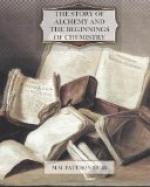separated into these quantities of those substances.
When water is formed by the union of hydrogen and
oxygen, in the ratio of 11.11 parts by weight of the
former to 88.89 of the latter, the properties of the
two substances which coalesce to form it disappear,
except their masses. It is customary to say that
water contains hydrogen and oxygen; but this
expression is scarcely an accurate description of
the facts. What we call substances are
known to us only by their properties, that is, the
ways wherein they act on our senses. Hydrogen
has certain definite properties, oxygen has other definite
properties, and the properties of water are perfectly
distinct from those of either of the substances which
it is said to contain. It is, therefore, somewhat
misleading to say that water contains substances
the properties whereof, except their masses, disappeared
at the moment when they united and water was produced.
Nevertheless we are forced to think of water as, in
a sense, containing hydrogen and oxygen. For,
one of the properties of hydrogen is its power to
coalesce, or combine, with oxygen to form water, and
one of the properties of oxygen is its ability to
unite with hydrogen to form water; and these properties
of those substances cannot be recognised, or even
suspected, unless certain definite quantities of the
two substances are brought together under certain
definite conditions. The properties which characterise
hydrogen, and those which characterise oxygen, when
these things are separated from all other substances,
can be determined and measured in terms of the similar
properties of some other substance taken as a standard.
These two distinct substances disappear when they
are brought into contact, under the proper conditions,
and something (water) is obtained whose properties
are very unlike those of hydrogen or oxygen; this
new thing can be caused to disappear, and hydrogen
and oxygen are again produced. This cycle of
changes can be repeated as often as we please; the
quantities of hydrogen and oxygen which are obtained
when we choose to stop the process are exactly the
same as the quantities of those substances which disappeared
in the first operation whereby water was produced.
Hence, water is an intimate union of hydrogen and oxygen;
and, in this sense, water may be said to contain hydrogen
and oxygen.
The alchemist would have said, the properties of hydrogen and oxygen are destroyed when these things unite to form water, but the essence, or substratum, of each remains. The chemist says, you cannot discover all the properties of hydrogen and oxygen by examining these substances apart from one another, for one of the most important properties of either is manifested only when the two mutually react: the formation of water is not the destruction of the properties of hydrogen and oxygen and the revelation of their essential substrata, it is rather the manifestation of a property of each which cannot be discovered except by causing the union of both.




